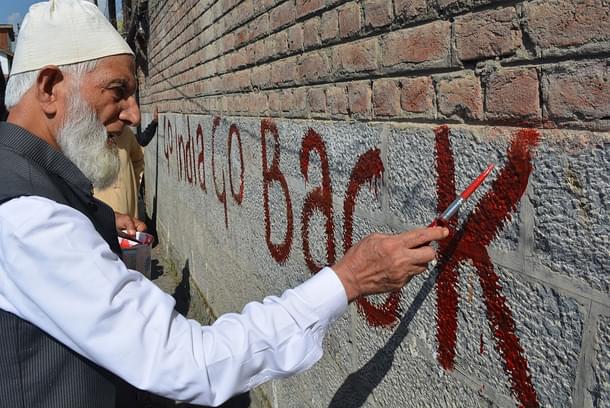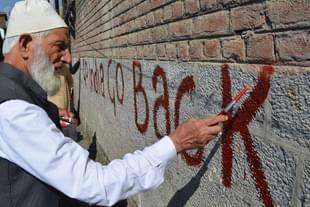Politics
Going Beyond Mere Geographic Integration: Ten Steps That Must Be Taken For The Kashmir Valley
Sanjay Dixit
Apr 11, 2017, 10:12 PM | Updated 10:12 PM IST
Save & read from anywhere!
Bookmark stories for easy access on any device or the Swarajya app.


Article 370 is India’s tribute to the two-nation theory propounded by Allama Iqbal and his disciple, Mohammad Ali Jinnah. It is an implicit recognition of Pakistan’s position.
For the sake of form, India and Sheikh Abdullah told the International audience including the United Nations that Kashmir was evidence that India did not believe in the two-nation theory. This is what Sheikh Abdullah said in the UN Security Council on 5 February 1948:
“I and my organization never believed in the formula that Muslims and Hindus form separate nations. We do not believe in the two-nation theory, nor in communal hatred or communalism itself. We believed that religion had no place in politics.”
If you told this to a Kashmiri today, he would probably laugh at you in your face, if not call you a downright fool. He would be justified in doing so, because this is exactly how India has behaved over 70 years. Jawaharlal Nehru succumbed to the wily designs of Sheikh Abdullah. He conceded Article 370 to Sheikh against the better judgment of Constituent Assembly. A history of how Article 370 came into being can be read here.
In the context of part 1 of this article, Article 370 only serves to strengthen the separate character of J&K in terms of the Islamic Shari’a ideology. Ethnic cleansing of Kashmiri Pandits is direct result of Article 370 and Article 35A of the Constitution. Therefore, no permanent solution for Kashmir can even be thought of before the abrogation of Article 370. India cannot honour the separate character of J&K in terms of Shari’a on the one hand and seek to integrate Kashmir into the mainstream on the other. This is where the game has to begin.
Second, the artificial artifice of Article 35A has to be taken out of the Statute book – this can be done even before repealing Article 370. This is a fraud on the Constitution of India and requires nothing more than a declaration that it was never made a part of the Constitution through due procedure.
Next, Jammu and Ladakh ought to be separated from the Valley and be constituted into an independent state or Union Territory. The politicians of the Valley have been ruling these two areas with the zeal of an Islamic majoritarian for the last 70 years, denying the greater area of Jammu and Kashmir (more than 80 per cent of the present area of Jammu and Kashmir under India) its due share in employment and economic opportunities. Jammu in particular has a great potential in industrial and agricultural development. Ladakh has the greatest potential as a tourism destination.
After these three steps have been taken, we can deal with the Islamic jihad of the Valley with a much greater focus and on a firm ideological footing. Once it is made clear to the Islamists and Jihadists that the Constitution of India shall reign supreme, the following Ten Commandments should logically follow:
One, the Kashmir Valley ought to be made a Union Territory with the Governor enjoying complete authority over law and order. The Valley elites have run with the hare and hunted with the hounds for far too long. India has to absolutely finish their divisive impact on the police and magistracy.
Two, having recognised the Taqlidi nature of Islam in the Valley (as in the rest of India), the Indian State can defeat the militancy if it concentrates on the clerics and mosques. Throughout the period of indoctrination, these two have been instrumental in fanning the flames in the Valley in league with the local politicians. Once the politicians are detached from law and order, it should not be difficult to target the clerics and mosques that are in the forefront of militancy. They have to be isolated by rigorous surveillance and exercise of legal options. These elements must fear the Indian State even as the public at large should feel that the State is just and fair. My impression is that the troublemakers are in a minority of less than 5 per cent, but occupy the vantage points.
Three, reoccupy the security grids which have gone soft over the last 10 years. Indian Army brought the Valley back from the brink in the nineties when the situation was much worse with thousands of mercenaries and local terrorists roaming not only the Valley, but also the upper reaches of the Chenab Valley. Today, there are fewer than 150 terrorists of the homegrown variety in the Kashmir Valley, and none in the Chenab Valley.
Four, end the endemic corruption in the Valley. A strong Governor to govern Union Territory of Kashmir would be required. A person with a military background may be advisable initially.
Five, resettle the Kashmiri Pandits in the Valley after creating fool proof security conditions. Panun Kashmir has been a long-standing demand of Kashmiri Pandits. Though it fortifies the two-nation theory, yet an autonomous region for the Pandits within the Union Territory of Kashmir may be worth looking at.
Six, put the occupation of infiltration routes as a tactical priority for the military once the local militancy is under control. Occupation of the Haji Pir bulge and other Neelam Valley infiltration routes should be prioritised subject to operational feasibility.
Seven, development of tunnels and transmission lines into the valley must be given priority over all other infrastructure projects. Winters are the best period for building trust with the general population without interference from the clerics and militants. Power situation in the winters and road blockages have been a sore point with the Valley. An investment of national will and resources would strengthen a belief that rest of India cares. In any case, any solution to resolving the crisis in the Valley has to ultimately isolate the jihad merchants from the lay population.
Eight, India must attempt the final resolution of the long pending dispute with Pakistan and China. With Pakistan, it has to be on the basis of the Accession Treaty of 1947. The UN Resolution is nearly defunct, and would be formally buried if Pakistan incorporates Gilgit-Baltistan into itself. A Ladakh type Union Terriotry with a legislative assembly would be an attractive solution to Pakistan-Occupied Kashmir (PoK) and Gilgit-Baltistan as well. India will have to use a hybrid approach of saam-daam-danda-bheda to win them over. With China, a climb down on the Johnson Line could yield results in the foreseeable future if the Indian economy keeps growing at 7-8 per cent for another decade or so.
Nine, India has to bring all political parties on board to resolve the Kashmir issue. This may be possible in the near future if the same party gets majority in both Lok Sabha and Rajya Sabha.
And last but not the least, there has to be absolute enforcement of Rule of Law.
With these Ten Commandments, we can expect that the territories of Maharaja Hari Singh would finally become an integral part of the Union of India de facto, rather than be so just de jure.
See also: The facade that is ‘Kashmiriyat’
Sanjay Dixit is IAS 1986 batch in the rank of Principal Secretary to Govt of Rajasthan. Posted as Commissioner of Enquiries. He tweets @Sanjay_Dixit




